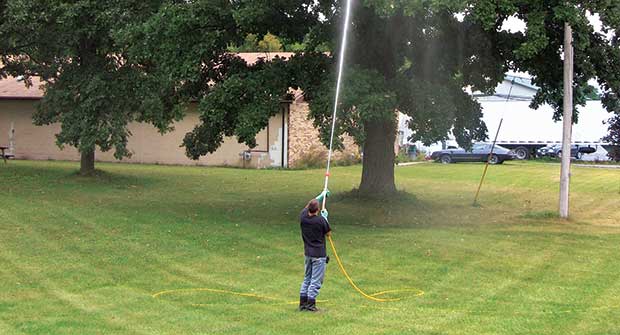
Whether applied in granular or liquid form, humates contain humic and folic acid that can improve turfgrass health, reduce nitrogen usage and enhance other nutrients.
Quick results
Paul Freeman — owner of The Grounds Guys of Evansville, Ind., a Neighborly company — uses humic acid in granular form and says he can see the lawn color improve within days.
“We use it when we gain a new lawn to show the difference in care from their previous vendor. Additionally, we utilize it in starter fertilizer,” Freeman says. “When we aerate and overseed a lawn, our germination rates increase, and the overall lawn is healthier.”
The Grounds Guys of Evansville, Ind., offers lawn care, landscape,hardscape, pest control, outdoor lighting, snow management, gutter and irrigation services for 73 percent commercial and 27 percent residential clients.
Freeman encourages LCOs looking to incorporate humates into their programs to test them on their own lawns or with a new customer to track the progress. Cost is also a factor to consider when deciding whether to include this.
“Adding humates to your program is another input that must be figured into your price,” Freeman says. “If you are the low-price leader, this program is not for you.”
Healthier turf
One of the benefits of using humates is the ability to extend the release curve of nitrogen applied, says John Perry, president of Greene County Fertilizer Co.
“This has been a well-studied benefit of humates, acting as a buffer for nitrogen applications,” Perry says. “This is something that can be either applied as a liquid or as a granular, and the effects of the carbon for the soil are just an added benefit.”
One concern LCOs often have about using humates in a granular form is the dust some of them may leave behind, though this issue has gotten better as more fertilizers have a coating, Perry says. While pros can apply humates throughout the year, he says liquids have better results with the turf’s root mass and overall health during the most active growth periods of the season.
“Applications of humates have shown that the turfgrass will become slightly darker in color, as well as over time have better water-holding capacity,” Perry says. “In addition, the overall density and the ability for the turfgrass to spread — in some turf varieties — will definitely increase an operator’s chance of success.”
Lower nitrogen use
Humates allow LCOs to improve soil health and reduce their overall nitrogen rates by a quarter to a third while achieving quality turfgrass results, says Ben Pease, turfgrass agronomist for The Andersons Plant Nutrient Group.
“It’s great for the environment to use less of our nutrient resources,” Pease says. “As supplies become more scarce or expensive, using humates is a great thing LCOs can do to proactively help the situation and differentiate their services from the competition.”
Pros can apply humates in either liquid or granular form, depending on what form of delivery the operator prefers and how much they want to put down. Granular forms can be up to 70 percent humic acid, whereas liquids will contain around 10 to 20 percent, Pease says. Operators can also apply humates in granular form, which leads to better long-term success.
No matter which form they use it in, Pease says it’s important for LCOs to consistently use humates each year to fully realize the benefits. Incorporating them into their fertility program once in the spring and fall will help give them a well-rounded program.
“There is an extra cost to add humates to fertilizers,” Pease says. “But if you’re offsetting that by using less nutrients, you come out about the same in cost—and can then tout the other benefits.”

